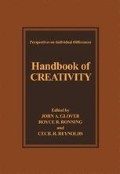Abstract
Informal thought about the nature of mental operations important to creative human behavior suggests that perceptual processes are of considerable importance. The ability to “see relationships among elements” is an attribution commonly made toward authors of major scientific discoveries or of noteworthy artistic achievements. For example, Shepard (1978, 1981) documented self-reports from several creative scientists and authors that strongly emphasize the role of visual imagery and the manipulation of visual codes in the creative process.
Access this chapter
Tax calculation will be finalised at checkout
Purchases are for personal use only
Preview
Unable to display preview. Download preview PDF.
References
Brooks, L. R. (1968). Spatial and verbal components of the act of recall. Canadian Journal of Psychology, 22, 349–368.
Gibson, J. (1966). The senses considered as perceptual systems. Boston: Houghton Mifflin.
Goodman, K. J., and Marquart, D. I. (1978). Creativity and perception: The neglected theory of Lowenfeld. Journal of Creative Behavior, 12, 279.
Guilford, J. P. (1967). The nature of human intelligence. New York: McGraw-Hill.
Guilford, J. P. (1981). Higher order structure of intellect abilities. Multivariate Behavioral Research, 16, 411–435.
Guilford, J. P. (1983). Transformation abilities or functions. Journal of Creative Behavior, 17, 75–83.
Hochberg, J. (1981). Levels of perceptual organization. In M. Kubovy and J. Pomerantz (Eds.), Perceptual organization (pp. 255–278 ). Hillsdale, NJ: Earlbaum.
Kahneman, D., and Tversky, A. (1973). On the psychology of prediction. Psychological Review, 80, 237–251.
Keefe, J. A., and Magaro, P. A. (1980). Creativity and schizophrenia: An equivalence of cognitive processing. Journal of Abnormal Psychology, 89, 390–398.
Kellogg, R. (1986). Designing ideal processors for document composition. Behavior Research Methods, Instruments, and Computers, 18, 118–128.
Kohler, W. (1947). Gestalt psychology. New York: Liveright.
Marks, L. (1978). The unity of the senses. New York: Academic Press.
Marks, L. (1982). Synesthetic perception and poetic metaphor. Journal of Experimental Psychology: Human Perception and Performance, 8, 15–23.
Newman, S. S. (1933). Further experiments in phonetic symbolism. American Journal of Psychology, 45, 53–75.
Paivio, A. (1971). Imagery and verbal processes. New York: Holt, Rinehart and Winston.
Paivio, A. (1978). Comparison of mental clocks. Journal of Experimental Psychology: Human Perception and Performance, 4, 61–71.
Place, E., and Gilmore, G. (1980). Perceptual organization in schizophrenia. Journal of Abnormal Psychology, 89, 409418.
Pomerantz, J., and Schwaitzberg, S. (1975). Grouping by proximity: Selective attention measures. Perception and Psycho-physics, 18, 355–361.
Pomerantz, J., Sager, L., and Stover, R. (1977). Perception of wholes and their component parts: Some configural superiority effects. Journal of Experimental Psychology: Human Perception and Performance, 3, 422–435.
Prentky, R. A. (1979). Creativity and psychopathology: A neurocognitive perspective. In B. Maher (Ed.), Progress in experimental personality research (Vol. 9, pp. 1–39). Academic Press.
Sapir, E. (1929). A study of phonetic symbolism. Journal of Experimental Psychology, 12, 225–239.
Segall, S. J., and Fusella, V. (1970). Influence of imaged pictures and sounds in detection of visual and auditory signals. Journal of Experimental Psychology, 83, 458–474.
Shepard, R. N. (1978). Externalization of mental images and the act of creating. In B. Randhawa and W. Coffman (Eds.), Visual learning, thinking, and communication (pp. 133–189 ). New York: Academic Press.
Shepard, R. N. (1981). Psychophysical complementarity. In M. Kubovy and J. Pomerantz (Eds.), Perceptual organization (pp. 279–341 ). Hillsdale, NJ: Earlbaum.
Stein, M. I. (1956). A transactional approach to creativity. In D. W. Taylor (Ed.), Research conference on the identification of creative talent. Salt Lake City: University of Utah Press.
Stevens, S. (1959). Cross-modality validation of subjective scales for loudness, vibration and electric shock. Journal of Experimental Psychology, 57, 201–209.
Taylor, D. W. (1960). Thinking and creativity. Annals of the New York Academy of Sciences, 91, 108–127.
Wells, D., and Leventhal, D. (1984). Perceptual grouping in schizophrenia: Replication of Place and Gilmore. Journal of Abnormal Psychology, 93, 231–234.
Author information
Authors and Affiliations
Editor information
Editors and Affiliations
Rights and permissions
Copyright information
© 1989 Springer Science+Business Media New York
About this chapter
Cite this chapter
Flowers, J.H., Garbin, C.P. (1989). Creativity and Perception. In: Glover, J.A., Ronning, R.R., Reynolds, C.R. (eds) Handbook of Creativity. Perspectives on Individual Differences. Springer, Boston, MA. https://doi.org/10.1007/978-1-4757-5356-1_8
Download citation
DOI: https://doi.org/10.1007/978-1-4757-5356-1_8
Publisher Name: Springer, Boston, MA
Print ISBN: 978-1-4419-3212-9
Online ISBN: 978-1-4757-5356-1
eBook Packages: Springer Book Archive

